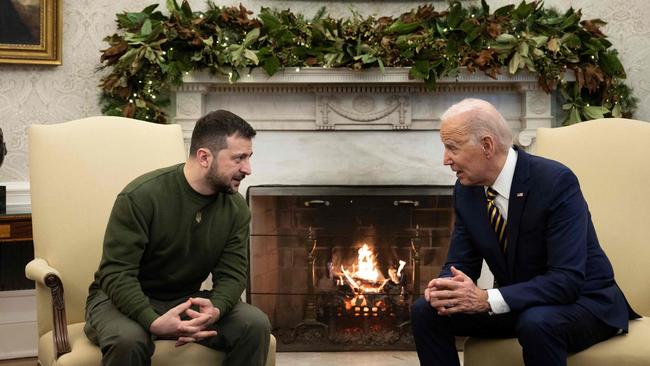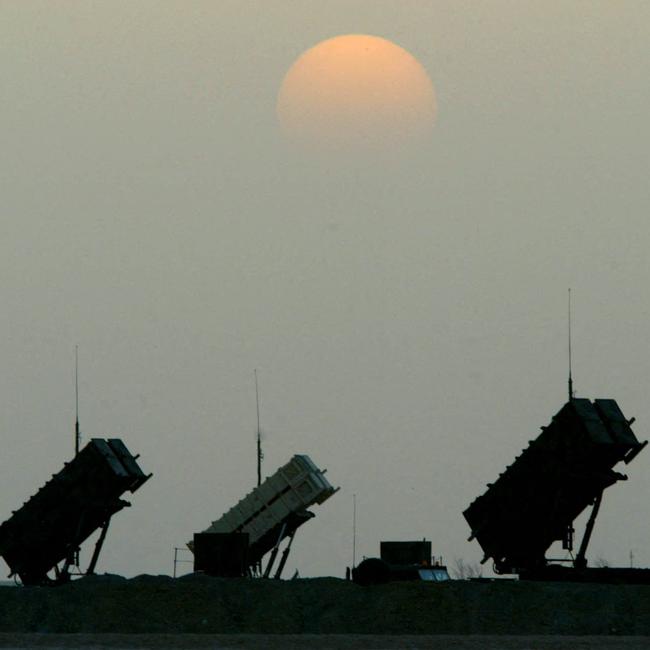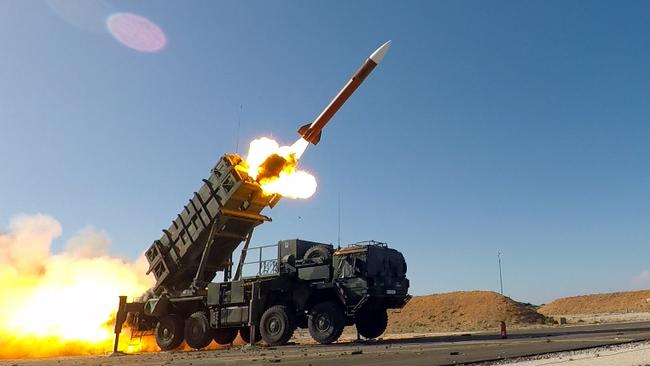US announces $3bn arms package amid visit by Ukraine’s Zelensky
The Biden administration package for the first time includes a Patriot air-defence system as well as equipment that converts unguided munitions into precision-guided missiles.
The Biden administration announced a nearly $US2 billion ($2.98bn) arms package for Ukraine that for the first time includes a Patriot air-defence system to help Kyiv protect itself against the barrage of ballistic missiles and cruise missiles Russia has unleashed on the country’s electrical grid and other infrastructure.
Also for the first time, the U.S. is providing kits that will enable Ukraine to use its bombs to carry out precision strikes against Russian forces. The $US1.85bn package comes as President Joe Biden welcomes Ukrainian President Volodymyr Zelensky, who is scheduled to visit the White House on Wednesday afternoon and address members of congress.
This is Mr Zelensky’s first trip outside Ukraine since the Russian invasion in February.
The lone Patriot air-defence battery the US is giving Ukraine will help fill a gap in Ukraine’s patchwork air defences, but it won’t be deployed immediately, nor dramatically change the balance in the war, according to current and former officials.
To further build up Ukraine’s air defences, the US has been quietly trying to persuade allied nations to contribute Patriot batteries, which are in short supply, from their own inventories, US officials say.
Even so, it will take months before Ukrainian troops are trained in Germany to use the system, making it unlikely the Patriot system will be sent to Ukraine before the spring.
“This will take some time,” a senior Biden administration official told reporters Tuesday night. The administration didn’t say when the Patriot battery would be operational in Ukraine, but some officials said that the training could take as long as five months.
Ukrainian officials appealed for Patriot batteries last year without success. But the need for the batteries became especially acute after Russia modified its strategy in October and began to pummel Ukraine’s electrical grid and other civilian infrastructure with ballistic missiles, cruise missiles and Iranian-made Shahed-136 drones. While the Ukrainians have shot down many of the missiles and drones, enough have reached their mark and cut millions of civilians off from electricity and heat.
The $US1.85bn includes $US1bn in direct arms transfers from U.S. stocks and an additional $850 million in military support through a separate fund known as the Ukraine Security Assistance Initiative, which funds Kyiv’s longer-term defence needs.
In addition to the Patriot battery, the $US1 billion also includes a Joint Direct Attack Munitions system, or JDAMs, a kit that enables the Ukrainian air force to more precisely target bombs it drops on Russian forces, US officials said.
The package also includes more HARM missiles that Ukraine’s air force can use to attack Russian radars and ammunition for the high mobility artillery rocket system, or Himars. In addition, 155mm artillery rounds, mortar systems and ammunition, bomb-resistant vehicles known as MRAPs and other vehicles and munitions.
In all, the Biden administration has now provided more than $US21bn since Russia invaded Ukraine on February 24.
The provision of the Patriots comes as some administration officials believe the winter could provide a natural inflection point in the war, now in its 10th month. Some officials, including Chairman of the Joint Chiefs of Staff Army General Mark Milley, believe the US, Russia and Ukraine should begin negotiating, though he said the decision to start such talks is up to Ukraine and Russia.

But a senior Biden administration official told reporters Tuesday night that Mr Biden wouldn’t press Mr Zelensky to open negotiations with Moscow, adding the administration didn’t foresee “diplomacy that would lead to an end to the war on just terms as being on the very near-term horizon.”
The US hasn’t provided aircraft, tanks or long-range ATACMS missiles, which Ukraine has long sought. Mr Zelensky plans to ask Mr Biden to send long-range missiles and drones that Ukraine could use to attack Russian military infrastructure in Crimea and other parts of Ukraine in exchange for giving the US joint decision-making on selecting targets, according to people who helped set up the Ukrainian president’s visit.
The Ukrainian president is also ready to offer guarantees that Ukraine’s forces won’t strike targets inside Russia with the weapons he will request, these people said.
Ukrainian officials broached the idea of letting the US approve targets earlier this year but failed to persuade the Biden administration to provide ATACMS. Mr Biden has long been concerned that giving Ukraine such long-range weapons would increase the risk of the war escalating into a direct US-Russian confrontation. The US has even made modifications to the Himars launchers it provided Kyiv so they couldn’t be used to fire ATACMS missiles if Ukraine were to acquire them from other countries.

While the decision to send the Patriot is a first, former officials said the deployment of a battery or two is unlikely to be a game changer.
Tom Karako of the Center for Strategic and International Studies, a Washington, DC-based think tank, said the radar in a Patriot battery could cover a 120-degree sector, so two batteries could cover most but not all of the aerial attack routes to Kyiv. The high cost and relatively limited number of the Patriot interceptors – each missile can cost $US4 million – limits the number of targets defenders can shoot.
While incoming ballistic missiles and enemy aircraft would be priority targets, it might only make sense to intercept cruise missiles if they were headed toward a sensitive target, he noted. As a general rule, it wouldn’t be cost effective to fire Patriot interceptors at cheap, slow-flying drones, which can be countered with antiaircraft guns, shoulder-fired missiles and Ukrainian planes.
A deployment of one or two batteries would produce “a relatively small defended area,’” Mr Karako wrote in a paper with Mark Cancian, also with CSIS”. It will protect only one piece of the country against certain kinds of threats. It will not put a protective bubble over all or even large parts of Ukraine.” Kremlin spokesman Dmitry Peskov said Moscow would target any Patriot batteries that are provided to Ukraine, a threat that will force Ukraine to protect the air-defence systems.

The US and its allies are also providing other air-defence systems, which could be stitched together to help defend Ukraine. They include two U.S. midrange Nasams systems, which are designed to target cruise missiles, aircraft and drones, with more to come over the next 18 months.
Germany is providing IRIS-T air defence systems, the first of which has been delivered. Spain has been sending US-made Hawk air-defence systems, while the U.S. is sending additional missiles for those systems to fire.
Ukraine has been using antiaircraft guns, fighter aircraft, shoulder-fired missiles and other ground-based defences to counter the Iran-made drones, according to a report by the London-based Royal United Services Institute, a think tank in London. The report said that Ukraine’s defence against the drones could be strengthened by the delivery of a large number of shoulder-fired missiles, antiaircraft guns and night-vision goggles, as many of the Russian attacks occur at night.
The Wall Street Journal







To join the conversation, please log in. Don't have an account? Register
Join the conversation, you are commenting as Logout